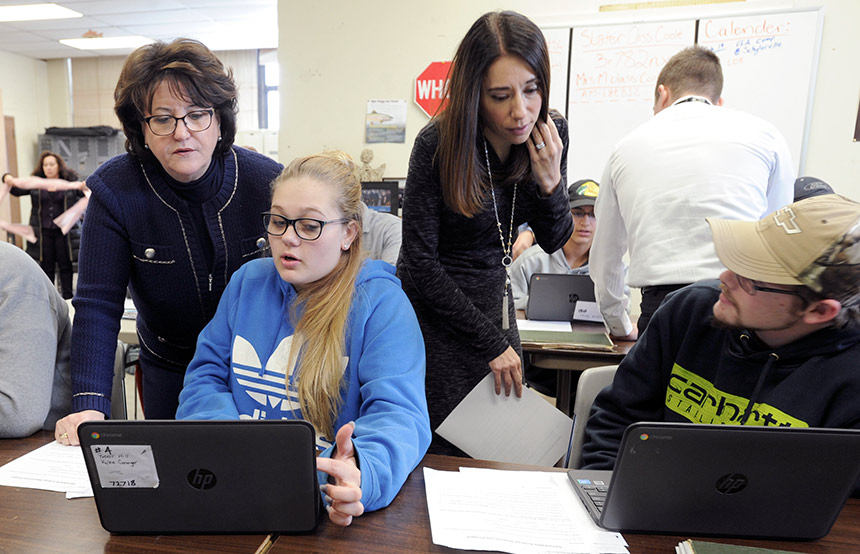State Education Commissioner MaryEllen Elia got a first-hand look at a union-backed student teaching residency program being piloted in a handful of North Country school districts and she liked what she saw.
As she stopped in classrooms at Hudson Falls High School, Hudson Falls Primary School and the BOCES Southern Adirondack Education Center, Elia saw aspiring teachers working side by side with experienced educators — not sitting in the back of the room observing.
Bailey Carlin, a “resident” student teacher who is working toward his master’s degree in teaching at SUNY Plattsburgh, explained the thinking behind a renewable energy resources project in an English class tailored for Career and Technical students at the Washington-Saratoga-Warren-Hamilton-Essex BOCES.
“Our goal is to take an English lesson and specialize it to the students’ interests and needs,” Carlin said. “We want it to be engaging and relevant — and hopefully make it so they don’t dread English class.”
Carlin, who is working with “attending” teacher Karen Monastero, said he is grateful to be part of the two-year residency program launched this fall by two rural Washington County school districts, the local BOCES and SUNY Plattsburgh’s Queensbury campus. “So far it’s been an amazing experience and I’ve learned so much,” he said. “I feel really lucky to be a part of this.” Monastero, a member of the Saratoga Adirondack BOCES Employees Association, is a National Board Certified Teacher.
The pilot program began last fall with a three-year $738,000 National Education Association grant to develop a clinically rich preparatory program and boost teacher recruitment and retention. Under the Classroom Academy model, aspiring teachers with bachelor’s degrees are placed in a two-year residency in Cambridge, Hudson Falls, and Washington-Saratoga-Warren-Hamilton-Essex BOCES. The program uses the same lingo as hospital residencies: Candidates are called “residents” and the experienced instructors overseeing their work are known as “attendings.”
Aside from getting first-hand classroom experience, each resident receives a $22,000-a-year living stipend to ensure equity and access, plus plenty of individualized and group support, and a year’s credit toward professional certification. Residents also take master’s level courses, participate in a monthly professional learning community, keep a reflective journal and will do clinical “rounds” to observe other practitioners. For example, this spring, SUNY Plattsburgh’s Maureen Squires, who heads the Master’s in Teaching program, will lead a clinical rotation focusing on special education.
The attending teachers receive a $4,500 stipend each year to recognize the complexity of their role and can use the experience to participate in the National Board Certification process. Participating attending teachers told Elia they view their residents as “co-teachers” and noted they are finding the partnership energizing and professionally rewarding.

Elia said the residency pilot is a promising approach and a powerful example of what can happen when universities and colleges partner with K-12 schools.
“This gives student teachers an opportunity to grow. The experiences they have through this program will set them up to be more successful,” Elia said. “This is going to be one of the models … as we take a look at how to improve the student teaching experience and make it more meaningful.”
Elia said aspiring teachers need more than an eight-week student teaching experience to be prepared and successful. “That’s why we’re losing people,” she said.
NYSUT Executive Vice President Jolene DiBrango, who accompanied Elia, Regent Beverly Ouderkirk and other SED officials on the tour, said the Classroom Academy approach shows what can happen when partners work together to find ways to support teachers.

“At a time when we’re facing a teacher shortage, we want to do everything we can to encourage people to enter the profession and most importantly, help them succeed,” DiBrango said.
Colleen McDonald, a recently retired teacher leader and Cambridge Faculty Association member who is overseeing the pilot program, said a key part of the NEA grant was creating a program that could be scaled up and sustainable, without depending on grant funding. Under a state-approved Contract for Shared Services funding arrangement through the local BOCES, the districts are reimbursed for a substantial portion of salaries.
Conservative estimates say the U.S. will need to hire more than 1.5 million new teachers in the near future, McDonald said.
“This is changing the way we look at teacher preparation,” she said.